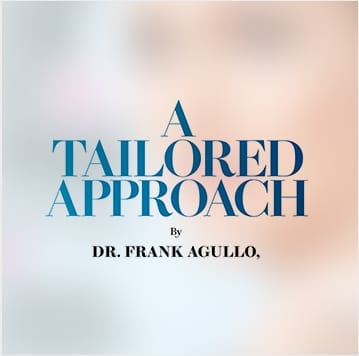
What Are the Benefits of Lip Shortening?
Lip shortening is ideal for women who:
- Feel dissatisfied with the downturned corners of their lips
- Desire a fuller upper lip that complements their facial features
- Yearn for improved facial proportions and balance
- Wish their lips had a better shape
- Want their teeth to be more exposed when smiling or speaking
Am I a Candidate for Lip Shortening?
Ideal candidates for lip lift surgery are displeased with their facial appearance due to having a long philtrum, a drooping cupid’s bow, downturned lip corners, fine lines around the mouth, and disproportionately sized lips.
Women interested in lip shortening:
- Are in good overall health
- Do not have any previous medical conditions that can impact their healing
- Do not smoke
- Have realistic expectations of their results
Are you a candidate for lip lift surgery? Call Dr. Agullo at (915) 590-7900 to set up a consultation.
What Is Discussed During My Lip Lift Consultation?
During your consultation, Dr. Agullo will:
- Discuss your wishes and expectations for your results
- Evaluate your lips and lower face to determine the appropriate lip shortening treatment for you
- Take photos

What Does My Lip Lip Include?
Various lip shortening techniques can be utilized to create fuller and more prominent lips. Lip shortening can be performed using local anesthesia, allowing patients to drive themselves home immediately following treatment. Some patients will choose IV sedation if they are overly anxious or desire to be more relaxed.
During your consultation, Dr. Agullo will determine the ideal lip enhancement approach to achieve your cosmetic objectives.
Subnasal Lip Lift
- A bullhorn-shaped incision is created beneath the nostrils, through which excess skin is removed
- The philtrum (the area between the nose and upper lip) is shortened
- Incisions are hidden at the base of the nose
Corner Lip Lift
- A tiny incision is placed at each side of the upper lip, through which minimal tissue is excised
- Can be performed in conjunction with the subnasal lip lift technique
- The incision is concealed along the edges of the lips
Lip Augmentation
- Lip augmentation helps make the lips more prominent and smooths fine lines
- Injectable fillers or fat transfer can be used for additional lip enhancement
Resurfacing
- Laser or radiofrequency treatments can be used at the same time as other techniques to remove fine or coarse wrinkles around the mouth for a total oral rejuvenation

How Should I Prepare for My Lip Shortening?
Planning and preparation are essential for a quicker and smoother recovery. Before your lip lift surgery, you should:
- Stop smoking for at least two weeks before your scheduled surgery, as this can increase your risk of complications like blood clots
- Avoid medication and herbal supplements that thin your blood for at least two weeks before your procedure
- Ensure that you have and bring your paperwork and identification
Because this procedure is performed using local anesthesia, there is no need to make arrangements for someone to transport the patient to and from the facility. Patients are advised to take one week off of work to allow any side effects to subside.
At Agullo Plastic Surgery, tailored care begins with a full consultation to discuss the goals and options available.
What Are Your Concerns?
What Can I Expect for My Lip Shortening Recovery?
Patients can expect to experience the bulk of their recovery during the first few days. Swelling should subside considerably within one week, but residual swelling can persist for as long as three months.
Is My Lip Shortening Painful?
Surgical techniques used during lip lift surgery procedures are performed with local anesthesia (or IV sedation) to ensure a pain-free operation. It is common to develop minor facial discomfort or tightness following the surgery. Applying cold compresses and taking over-the-counter pain medication can help alleviate any postoperative discomfort.
Will My Lip Shortening Leave Scars?
Minor incisions are made, so there is a possibility of scars. Thankfully, Dr. Agullo makes these incisions in discreet areas, such as the natural crease beneath the nostrils. These creases hide resulting scars.
When Will I See My Lip Lift Surgery Results?
You will start to see your lip shortening results immediately after your treatment; however, bruising and swelling will camouflage the final results initially. It can take several weeks or months for you to see your full transformation.
What Are Some Frequently Asked Questions About Lip Lifts?
While complications following lip lift surgery are rare, some of the potential risks may include:
- Infection
- Hematoma or seroma
- Scarring
- Changes in sensation
You can reduce your chance of experiencing these complications by following all of Dr. Agullo’s pre- and post-surgical advice.
The ideal space between the upper lip and the bottom of the nose varies with gender. For females, a distance between 1.0 and 1.2 cm is optimal, and in men, 1.3 to 1.8 cm is considered optimal.
Patients with thin lips may want to consider lip shortening surgery to achieve a plumper pout. This procedure shortens the space between the nose and upper lip to produce a fuller lip aesthetic. Some patients may also pair lip lift surgery with augmentation for optimal results.
The longevity of your lip shortening results will vary depending on the specific technique used. Surgical techniques, such as a subnasal lip lift or a corner lip lift will last significantly longer than lip augmentation using fillers or resurfacing treatments. Regardless of the option you choose, it is important to remember that these treatments do not stop the aging process. You will continue to age at a natural rate, which may include the further elongation of the area above the lip.
Interested in Lip Shortening in El Paso?
If you want to learn more about Dr. Agullo’s lip lift techniques, contact his office by calling (915) 590-7900. Dr. Agullo offers lip shortening for patients in El Paso, Texas, and the greater El Paso area.
Catch full transformations live on Snapchat or Instagram @RealDrWorldWide on any given day! #StayBeautiful




